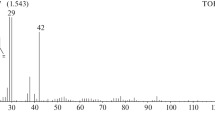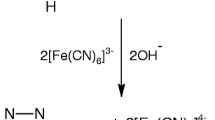Abstract
The kinetics of the oxidation of an aminotriazole formamidine derivative, N,N-dimethyl-N′-(4H-1,2,4-triazol-3-yl) formamidine (ATF) by cerium(IV) has been studied spectrophotometrically in aqueous perchloric and sulfuric acid solutions at constant ionic strength of 1.0 mol·dm−3. In both acids, the reaction shows first order kinetics with respect to [Ce(IV)], whereas the orders with respect to [ATF] are less than unity. The reaction exhibits negative fractional order kinetics with respect to [H+]. The rates of reaction are not significantly affected by variations of either ionic strength or relative permittivity of the reaction’s media. Addition of cerium(III) product does not affect the rates. Plausible mechanistic schemes for the reactions have been proposed. In both cases, the final oxidation products were identified as aminotriazole, dimethyl amine and carbon dioxide. Under comparable experimental conditions, the oxidation rate in perchloric acid solution is about sixfold higher than that in sulfuric acid solution. The effect of temperature on the rates has also been studied and activation parameters have been evaluated and discussed. The rate laws associated with the reaction mechanisms are derived.













Similar content being viewed by others
References
Fawzy, A.: Oxidation of alginate and pectate biopolymers by cerium(IV) in perchloric and sulfuric acid solutions: a comparative kinetic and mechanistic study. Carbohydr. Polym. 138, 356–364 (2016)
Mathur, S., Yadav, M.B., Devra, V.: Kinetics and mechanism of uncatalyzed and Ag(I) catalyzed oxidation of hydroxylysine by cerium(IV) in acid medium. J. Phys. Chem. Biophys. 3, 5–12 (2013)
Mathur, S., Yadav, M.B., Devra, V.: Kinetics and mechanism of uncatalyzed and Ag(I) catalyzed oxidation of serine by cerium(IV) in acid medium. Int. J. Res. Phys. Chem. 5, 1–6 (2015)
Thabaj, K.A., Chimatadar, S.A., Nandibewoor, S.T.: Mechanistic study of oxidation of palladium(II) by cerium(IV) in aqueous acid. Transit. Met. Chem. 31, 186–193 (2006)
Bolattin, M., Meti, M., Nandibewoor, S.T., Chimatadar, S.A.: Catalytic activity of ruthenium(III) and thermodynamic study of oxidative degradation of chloramphenicol by cerium(IV) in sulfuric acid medium. J. Solution Chem. 44, 152–169 (2015)
Hosahalli, R.V., Savanur, A.P., Nandibewoor, S.T., Chimatadar, S.A.: Ruthenium(III)-mediated oxidation of D-mannitol by cerium(IV) in aqueous sulfuric acid medium: a kinetic and mechanistic approach. Int. J. Chem. Kinet. 42, 440–452 (2010)
Das, A.K., Islam, M., Bayen, R.: Studies on kinetics and mechanism of oxidation of D-sorbitol and D-mannitol by cerium(IV) in aqueous micellar sulfuric acid media. Int. J. Chem. Kinet. 40, 445–453 (2008)
Adari, K.K., Nowduri, A., Parvataneni, V.: Kinetics and mechanism of oxidation of L-cystine by cerium(IV) in sulphuric acid medium. Acta Chim. Slov. 55, 425–429 (2008)
Sumathi, T., Shanmugasundaram, P., Chandramohan, G.: A kinetic and mechanistic study on the silver(I) catalyzed oxidation of l-serine by cerium(IV) in sulfuric acid medium. J. Saudi Chem. Soc. 17, 227–235 (2011)
Hassan, R.M., Alaraifi, A., Fawzy, A., Zaafarany, I.A., Khairou, K.S., Ikeda, Y., Takagi, H.D.: Acid-catalyzed oxidation of some sulfated polysaccharides. Kinetics and mechanism of oxidation of kappa-carrageenan by cerium(IV) in aqueous perchlorate solutions. J. Mol. Cat. A 332, 138–144 (2010)
Naik, D.V., Byadagi, K.S., Nandibewoor, S.T., Chimatadar, S.A.: Kinetics and mechanistic study of manganese(II)-catalyzed cerium(IV) oxidation of thiamine hydrochloride in aqueous perchloric acid medium by stopped flow technique. Monatsh. Chem. 144, 1307–1317 (2013)
Byadagi, K.S., Naik, D.V., Savanur, A.P., Nandibewoor, S.T., Chimatadar, S.A.: Ruthenium(III) mediated oxidation of thiamine hydrochloride by cerium(IV) in perchloric acid medium: a kinetic and mechanistic approach. React. Kinet. Mech. Catal. 99, 53–61 (2010)
Jattinagoudar, L.N., Byadagi, K.S., Nandibewoor, S.T., Chimatadar, S.A.: Kinetics and mechanism of cerium(IV) oxidation of fosfomycin disodium salt: an antibiotic drug in acid perchlorate solutions. Synth. React. Inorg. Met. Org. Nano Met. Chem. 45, 1138–1144 (2015)
Khan, F., Kushwaha, U., Singh, A.K.: A mechanistic study based on kinetics of the oxidation of diethyl ketone by Ir(III) chloride in aqueous perchloric acid medium when cerium (IV) perchlorate is used as a catalyst. J. Chem. Pharm. Res. 4, 3715–3726 (2012)
Yadav, M.B., Derva, V., Rani, A.: Kinetics and mechanism of uncatalyzed and silver(I) catalyzed oxidation of lysine by cerium(IV) in acid perchlorate medium. J. Indian Chem. Soc. 86, 600–604 (2009)
Datt, N., Nagori, R.R., Mehrotra, R.N.: Kinetics and mechanisms of oxidations by metal ions. Part VI. Oxidation of α-hydroxy acids by cerium(IV) in aqueous nitric acid. Can. J. Chem. 64, 19–23 (1986)
Beeman, R.W., Matsumura, F.: Chlordimeform: a pesticide acting upon amine regulatory mechanisms. Nature 242, 273–274 (1973)
Aziz, S.A., Knowles, C.O.: Inhibition of monoamine oxidase by the pesticides chlordimeform and related compounds. Nature 242, 417–418 (1973)
Leung, V.S.K., Chan, T.Y.K., Yeung, V.T.F.: Ami-traz poisoning in humans. Clin. Toxicol. 37, 513–514 (1999)
Nakayama, A., Sukekawa, M., Eguchi, Y.: Stereo-chemistry and active conformation of a novel insecticide. Acetamiprid Pesticide Sci. 51, 157–164 (1997)
Fawzy, A., Shaaban, M.R.: Kinetic and mechanistic investigations on the oxidation of N′-heteroaryl unsymmetrical formamidines by permanganate in aqueous alkaline medium. Transit. Met. Chem. 39, 379–386 (2014)
Hardwick, T.J., Robertson, E.: Ionic species in ceric perchlorate solutions. Can. J. Chem. 29, 818–828 (1951)
Vogel, A.I.: Text Book of Practical Organic Chemistry Including Quantitative Organic Analysis, 3rd edn, p. 332. ELBS, Longman (1973)
Feigl, F.: Spot Tests in Organic Analysis, p. 195. Elsevier, New York (1975)
Sherill, M.S., King, C.B., Spooner, R.C.: The oxidation potential of cerous-ceric perchlorates. J. Am. Chem. Soc. 65, 170–179 (1943)
Heidt, L.J., Smith, M.E.: Quantum yields of the photochemical reduction of ceric ions by water and evidence for the dimerization of ceric ions. J. Am. Chem. Soc. 70, 2476–2481 (1948)
King, E.L., Pandow, M.L.: The spectra of cerium(IV) in perchloric acid. Evidence for polymeric species. J. Am. Chem. Soc. 74, 1966–1969 (1952)
Offner, H.G., Skoog, D.A.: Hydrolysis constant of quadrivalent cerium from spectrometric measurements. Anal. Chem. 38, 1520–1521 (1966)
Chimatadar, S.A., Madawale, S.V., Nandibewoor, S.T.: Mechanistic study of iodide catalysed oxidation of l-glutamic acid by cerium(IV) in aqueous sulphuric acid medium. Transit. Met. Chem. 32, 634–641 (2007)
Leal, J.M., Domingo, P.L., Garcla, B., Ibeas, S.: Alkali metal ion catalysis of the oxidation of L-ascorbic acid by hexacyanoferrate(III) in strongly acidic media. J. Chem. Soc. Faraday Trans. 89, 3571–3577 (1993)
Frost, A.A., Person, R.G.: Kinetics and Mechanism, p. 147. Wiley Eastern, New Delhi (1973)
Amis, E.S.: Solvent Effect on Reaction Rates and Mechanism, p. 28. Academic Press, New York (1966)
Michaelis, L., Menten, M.L.: The kinetics of invertase action. Biochem. Z. 49, 333–369 (1913)
Fawzy, A.: Kinetics and mechanistic approach to the oxidative behavior of biological anticancer platinum(IV) complex towards l-asparagine in acid medium and the effect of copper(II) catalyst. Int. J. Chem. Kinet. 47, 1–12 (2015)
Freeman, F., Fuselier, C.O., Armstead, C.R., Dalton, C.E., Davidson, P.A., Karchesfski, E.M., Krochman, D.E., Johnson, M.N., Jones, N.K.: Permanganate ion oxidations. 13. Soluble manganese(IV) species in the oxidation of 2,4(1H,3H)-pyrimidinediones (uracils). J. Am. Chem. Soc. 103, 1154–1159 (1981)
Hicks, K.W., Toppen, D.L., Linck, R.G.: Inner-sphere electron-transfer reactions of vanadium(II) with azidoamine complexes of cobalt(III). Inorg. Chem. 11, 310–315 (1972)
Walling, C.: Free Radical in Solutions, p. 38. Academic Press, New York (1957)
Fawzy, A.: Influence of copper(II) catalyst on the oxidation of l-histidine by platinum(IV) in alkaline medium: a kinetic and mechanistic study. Transit. Met. Chem. 39, 567–576 (2014)
Fawzy, A., Asghar, B.H.: Kinetics and mechanism of uncatalyzed and silver(I)-catalyzed oxidation of l-histidine by hexachloroplatinate(IV) in acid medium. Transit. Met. Chem. 40, 287–295 (2015)
Shukla, A., Gupta, S., Upadhyay, S.K.: Pd(II) complexes of amino alcohols and their reaction with chloramine-T: a kinetic study. Int. J. Chem. Kinet. 23, 279–288 (1991)
Author information
Authors and Affiliations
Corresponding author
Appendices
Appendix 1
Derivation of rate law in the case of perchloric acid.
According to the suggested mechanism and regarding to reaction (5),
Regarding to reactions (3) and (4),
and
Substituting Eq. 27 into Eq. 25 leads to,
The total concentration of ATF is given by:
where ‘T’ and ‘F’ stand for total and free concentrations.
Substituting Eq. 27 into Eq. 29 and rearrangement gives,
Therefore,
In view of low [Ce4+], the second denominator term K OH K[Ce4+]/[H+] in the above equation is neglected. Therefore,
Also,
Substituting Eqs. 26 and 27 into Eq. 34,
Substituting Eqs. 33 and 37 into Eq. 28 (and omitting ‘T’ and ‘F’ subscripts) leads to,
Under pseudo-first order condition, the rate-law can be expressed by Eq. 39,
Comparing Eqs. 38 and 39, the following relationship is obtained,
and with rearrangement, the following equations are obtained,
Appendix 2
Derivation of rate law in case of sulfuric acid.
According to the suggested mechanism and regarding to reaction (16),
Regarding reactions (14) and (15),
Substituting Eq. 45 into Eq. 43 leads to,
The total concentration of ATF is given by:
Substituting Eq. 45 into Eq. 47 and rearrangement gives,
Therefore,
In view of low [HCe(SO4) −3 ], the second numerator term in the above equation is neglected. Therefore,
Also,
Substituting Eqs. 44 and 45 into Eq. 52,
Substituting Eqs. 51 and 55 into Eq. 46 leads to,
Under pseudo-first order condition, the rate-law can be expressed by Eq. 57,
Comparing Eqs. 56 and 57, the following relationship is obtained,
and with rearrangement, the following equations are obtained:
Rights and permissions
About this article
Cite this article
Fawzy, A. Kinetic and Mechanistic Aspects of Oxidation of Aminotriazole Formamidine by Cerium(IV) in Aqueous Perchloric and Sulfuric Acid Solutions: A Comparative Study. J Solution Chem 45, 246–264 (2016). https://doi.org/10.1007/s10953-016-0438-1
Received:
Accepted:
Published:
Issue Date:
DOI: https://doi.org/10.1007/s10953-016-0438-1




